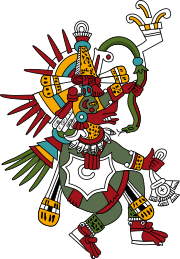Ehecatl

Ehecatl (Classical Nahuatl: Ehēcatl [eʔˈeːkatɬ]) is a pre-Columbian deity associated with the wind, who features in Aztec mythology and the mythologies of other cultures from the central Mexico region of Mesoamerica. He is most usually interpreted as the aspect of the Feathered Serpent deity (Quetzalcoatl in Aztec and other Nahua cultures) as a god of wind, and is therefore also known as Ehecatl-Quetzalcoatl.[1] Ehecatl also figures prominently as one of the creator gods and culture heroes in the mythical creation accounts documented for pre-Columbian central Mexican cultures.[2]

Since the wind blows in all directions, Ehecatl was associated with all the cardinal directions. His temple was built as a cylinder in order to reduce the air resistance, and was sometimes portrayed with two protruding masks through which the wind blew.
Mythology
As the fourth sun was destroyed in the Aztec creation myth (due to the gods not being satisfied with the men they had created), the gods gathered in Teotihuacan. There Nanahuatzin and Tecciztecatl jumped into a sacrificial fire and became the sun and the moon. They remained immobile until Ehecatl blew hard on them.
In the Aztec legend of the creation of the Fifth Sun, Ehecatl helped to sacrifice all of the gods, including Xolotl who tried to escape by transforming himself in to multiple forms until he became an Axolotl.[3] Ehecatl once fell in love with a human, Mayahuel. Their lovemaking caused a tree to grow.
Notes
- ↑ Miller and Taube (1993, p. 84)
- ↑ Miller and Taube (1993, pp. 70,84)
- ↑ http://www.mexicolore.co.uk/aztecs/stories/story-of-the-fifth-sun
References
- Carrasco, David (1982). Quetzalcoatl and the Irony of Empire: Myths and Prophecies in the Aztec Tradition. Chicago, IL: University of Chicago Press. ISBN 0-226-09487-1. OCLC 0226094871.
- Milbrath, Susan (1999). Star Gods of the Maya: Astronomy in Art, Folklore, and Calendars. The Linda Schele series in Maya and pre-Columbian studies. Austin: University of Texas Press. ISBN 0-292-75225-3. OCLC 40848420.
- Miller, Mary; Karl Taube (1993). The Gods and Symbols of Ancient Mexico and the Maya: An Illustrated Dictionary of Mesoamerican Religion. London: Thames & Hudson. ISBN 0-500-05068-6. OCLC 27667317.
- Séjourné, Laurette (1981). El pensamiento náhuatl cifrado por los calendarios. Colección América nuestra. América indígena, no. 35 (in Spanish). Josefina Oliva de Coll (trans.), Françoise Bagot (illus.), Julio Pliego (photog.). Mexico D.F: Siglo XXI Editores. ISBN 968-23-1057-1. OCLC 8563957.
- Smith, Michael E. (2003). The Aztecs (2nd ed.). Oxford and Malden, MA: Blackwell Publishers. ISBN 0-631-23015-7. OCLC 48579073.
- Wimmer, Alexis (2006). "Dictionnaire de la langue nahuatl classique" (online version, incorporating reproductions from Dictionnaire de la langue nahuatl ou mexicaine [1885], by Rémi Siméon). (French) (Nahuatl)
